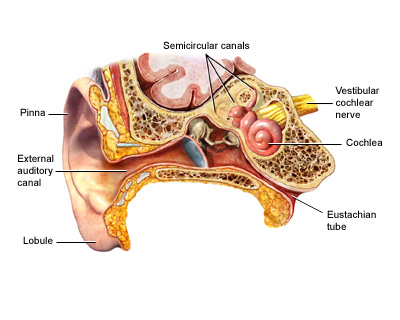Ruptured Eardrum
Content
Causes
Symptoms
Exams and Tests
Treatment
Outlook (Prognosis)
When to Contact a Medical Professional
Prevention

A ruptured eardrum is an opening or hole in the eardrum. The eardrum is a thin piece of tissue that separates the outer and middle ear. Damage to the eardrum may harm hearing.
Causes
Ear infections may cause a ruptured eardrum. This occurs more often in children. The infection causes pus or fluid to build up behind the eardrum. As the pressure increases, the eardrum may break open (rupture).
Damage to the eardrum can also occur from:
· A very loud noise close to the ear, such as a gunshot
· A rapid change in ear pressure, which may occur when flying, scuba diving, or driving in the mountains
· Foreign objects in the ear
· Injury to the ear (such as from a powerful slap or explosion)
· Inserting cotton-tipped swabs or small objects into the ears to clean them
Symptoms
Ear pain may suddenly decrease right after your eardrum ruptures.
After the rupture, you may have:
· Drainage from the ear (drainage may be clear, pus, or bloody)
· Ear noise/buzzing
· Earache or ear discomfort
· Hearing loss in the involved ear (hearing loss may not be total)
· Weakness of the face, or dizziness (in more severe cases)
Exams and Tests
The health care provider will look in your ear with an instrument called an otoscope. If the eardrum is ruptured, the doctor will see an opening in it. The bones of the middle ear may also be visible.
Pus draining from the ear may make it harder for the doctor to see the eardrum.
Audiology testing can measure how much hearing has been lost.
Treatment
You can take steps at home to treat ear pain.
· Put warm compresses on the ear to help relieve discomfort.
· Use medicines such as ibuprofen or acetaminophen to ease pain.
The opening in the eardrum most often heals by itself within 2 months if it is a small hole. Keep the ear clean and dry while it is healing.
· Place cotton balls in the ear while showering or shampooing to prevent water from entering the ear.
· Avoid swimming or putting your head underneath the water.
Your provider may prescribe antibiotics (oral or ear drops) to prevent or treat an infection.
Repair of the eardrum might be needed for larger holes or ruptures or if the eardrum does not heal on its own. This can be done either in the office or under anesthesia.
· Patch the eardrum with a piece of the person's own tissue taken (called tympanoplasty). This procedure will usually take 2 to 3 hours.
· Repair smaller holes in the eardrum by placing either gel or a special paper over the eardrum (called myringoplasty). This procedure will usually take 10 to 30 minutes.
Outlook (Prognosis)
The opening in the eardrum most often heals by itself within 2 months if it is a small hole.
Hearing loss will be short-term if the rupture heals completely.
Rarely, other problems may occur, such as:
· Long-term hearing loss
· Spread of infection to the bone behind the ear (mastoiditis)
· Long-term vertigo and dizziness
When to Contact a Medical Professional
If your pain and symptoms improve after your eardrum ruptures, you may wait until the next day to see your provider.
Call your provider right away after your eardrum ruptures if you:
· Are very dizzy
· Have a fever, general ill feeling, or hearing loss
· Have very bad pain or a loud ringing in your ear
· Have an object in your ear that does not come out
· Have any symptoms that last longer than 2 months after treatment
Prevention
DO NOT insert objects into the ear canal, even to clean it. Objects stuck in the ear should only be removed by a provider. Have ear infections treated promptly.
Source https://medlineplus.gov/ency/article/001038.htm

